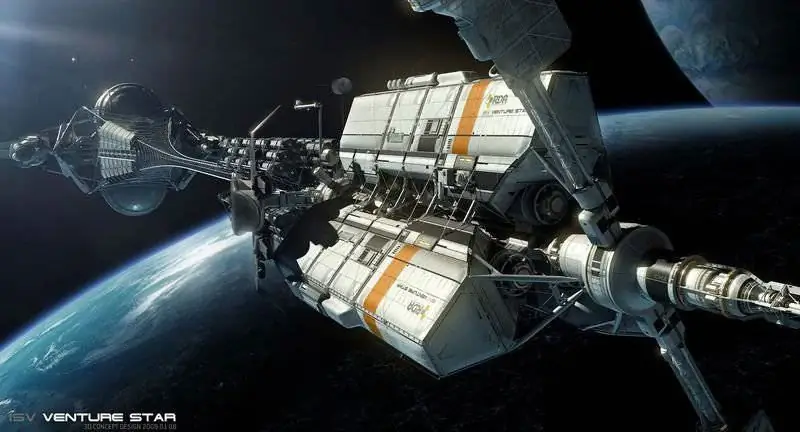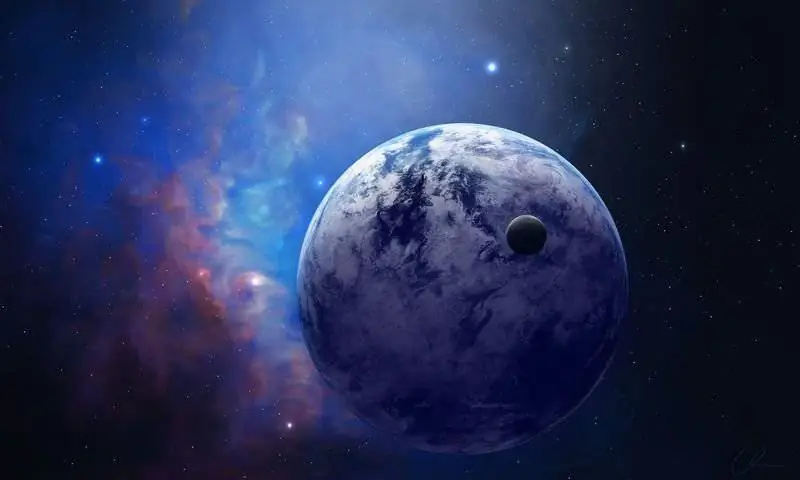- Author Matthew Elmers [email protected].
- Public 2023-12-16 21:49.
- Last modified 2025-01-24 09:17.
Scientists say that humanity is moving in small steps towards a future in which flights from one planetary system to another will finally become a reality. According to the latest estimates of experts, such a future may come within one or two centuries, if scientific progress does not stagnate. At one time, only with the help of the Kepler super-powerful telescope, astronomers were able to detect 54 potentially habitable exoplanets. All these worlds far from us are located in the so-called habitable zone, at a certain distance from the central star, which makes it possible to maintain liquid water on the planet.
At the same time, it is rather difficult to get an answer to the most important question - are we alone in the Universe. Due to the very large distances that separate the solar system and our closest neighbors. For example, one of the "promising" planets Gliese 581g is located at a distance of 20 light years, which is quite close by the standards of space, but still very far away for conventional terrestrial technologies. The abundance of exoplanets within a radius of 100 or less light years from our home planet and the very great scientific and even civilizational interest that they represent for all mankind make us look at the hitherto fantastic idea of interstellar travel in a completely new way.
The main task facing cosmologists and engineers today is the creation of a fundamentally new engine that would allow earthlings to cover vast space distances in a relatively short time. At the same time, of course, there is no talk of making intergalactic flights. For a start, humanity could explore our home galaxy - the Milky Way.

The Milky Way is made up of a large number of stars around which planets revolve. The star closest to the Sun is called Alpha Centauri. This star is 4, 3 light years or 40 trillion kilometers from Earth. If we assume that a rocket with an ordinary engine will fly off our planet today, then it will be able to cover this distance only in 40 thousand years! Of course, such a space mission looks completely absurd. Mark Millis, former head of NASA's engine technology project and founder of the Tau Zero Foundation, believes that humanity needs a long and methodical approach to creating a new type of engine. Nowadays, there are already a huge number of theories about what this engine will be, but which theory will work, we do not know. Therefore, Millis considers it senseless to focus only on one particular technology.
Scientists today have concluded that spacecraft of the future will be able to fly using a thermonuclear engine, solar sail, antimatter engine, or a space-time warp engine (or warp engine, which is well known to fans of the Star Trek series). The latter engine, in theory, should make possible flights faster than the speed of light, and hence small travel in time.
At the same time, all the listed technologies are only described, no one knows how to implement them in practice. For the same reason, it is not clear which technology is the most promising for implementation. True, a number of solar sails have already managed to fly into space, but a manned mission of interstellar flights will require a huge sail the size of the Arkhangelsk region. The principle of operation of a solar sail practically does not differ from that of a wind sail, only instead of air streams it catches ultra-focused beams of light emitted by a powerful laser system rotating around the Earth.

Mark Millis, in a press release from his Tau Zero foundation, says that the truth is somewhere in the middle between the already almost familiar solar sails and absolutely fantastic developments, such as a warp drive. “It is necessary to carry out scientific discoveries and slowly but surely move towards the intended goal. The more people we can get interested, the more funding we will attract, it is funding that is sorely lacking at the moment,”says Millis. Mark Millis believes that funding for large projects should be collected bit by bit, not expecting that someone will unexpectedly invest a fortune in the implementation of ambitious plans of scientists.
Today all over the world there are a lot of enthusiasts who believe and are confident that the future must be built now. Richard Obuzi, President and Co-founder of Icarus Interstellar, notes: “Interstellar travel is an international multi-generational initiative that requires tremendous intellectual and financial investment. Already today, we must initiate the necessary programs so that in a hundred years mankind could break out of our solar system."
In August this year, the Icarus Interstellar company is going to hold the Starship Congress scientific conference, at which the world's leading experts in this field will discuss not only the possibilities, but also the consequences of interstellar flights. The organizers note that a practical part will be organized at the conference, which will consider both short-term and long-term prospects for human exploration of deep space.

It is worth noting that such space travel requires a colossal amount of energy, which humanity today does not even think about. At the same time, improper use of energy can cause irreparable harm to both the Earth and those planets on the surface of which a person wants to land. Despite all the unresolved problems and obstacles, both Obuzi and Millis believe that human civilization has every chance to leave the limits of its "cradle". The invaluable data on exoplanets, star systems and alien worlds, which have been collected by the space observatories "Herschel" and "Kepler", will help scientists in the careful preparation of flight plans.
To date, the existence of about 850 exoplanets has been discovered and confirmed, many of which are super-earths, that is, planets with a mass that is comparable to that of Earth. Experts believe that the day is not far off when astronomers will be able to confirm the existence of an exoplanet that would be like two drops of water like our own. In this case, funding for projects to create new rocket engines would increase significantly. Extraction of minerals from asteroids should also play a role in space exploration, which now sounds less unusual than the same interstellar flights. Humanity must learn to use the resources not only of the Earth, but of the entire solar system, experts say.
Scientists and engineers from the US space agency NASA, as well as the US Defense Advanced Research Projects Agency (DARPA), have joined in the problem of interstellar travel. They are ready to unite their efforts within the framework of the "100-year Starship" project, and this is not even a project, but a project of a project. The 100-year Starship is a spacecraft capable of interstellar travel. The challenge for the current phase of research is to create the “sum of technologies” that are needed to make interstellar travel a reality. In addition, a business model is being created that would allow attracting investments to the project.

According to Pavel Eremenko, who is the press secretary of DARPA, this project will need “stable investments in financial and intellectual capital” from various sources. Eremenko also stressed that the goal of the "100-year Starship" project is not only the development and subsequent construction of a starship. “We are working hard to spark generations of interest in innovation and disruptive technology discoveries across multiple disciplines.”
The DARPA agency's specialists hope that the results that will be obtained during the work on this project can be used by the US Department of Defense in various fields, such as life support systems, energy, and computing.






